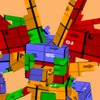
1. Type GCOPY and look at the documentation. (blue question mark) Despite it being translated poorly at some times, it still works.
2. BG tiles would work better for the moving foreground. GOFS is your friend for the background.
3. I have no idea how SPHIT works... will edit with more info soon.
4. Maybe use a SPANIM with the sword graphic on the sword sprite for 15 frames, then once it's done animating (check status with SPCHK) hide it. Wouldn't recommend SPCLRing it because it's most likely used a lot.
IF BUTTON(2) AND #B THEN:SPSHOW SWORD_ID:SPANIM SWORD_ID,"I",15,145,1 IF SPCHK(SWORD_ID)<1 THEN:SPHIDE SWORD_ID5. Check if you have background layers allocated. The top screen and bottom screen share 4 background layers, as well as splitting the 512 available sprites. To change the number of background layers and sprites given to the top screen, use the optional second parameter and the optional third parameter.
XSCREEN 2,256,3 'Gives the top screen 3 layers and 256 sprites to work with. 'This gives the bottom screen the remaining 1 layer and other 256 sprites.6. I don't quite understand what you're asking in this one. If you're asking about how to make maps good, it's better to load maps from DAT files, which are essentially arrays that you can load. Plug for one of my programs: To easily load and create maps, use the V360 Map Editor, available in V360 Grab Bag, only on SmileBASIC Source! ======== Unrelated protip for easy scrolling backgrounds: if you want to keep a value (x coordinate, coins, whatever) in-between 0 and some other value, and wrap around, use MOD
C=0 WHILE 1 VSYNC 15 C=(C+1) MOD 15 'Limit to 0->14, wrap around WEND
